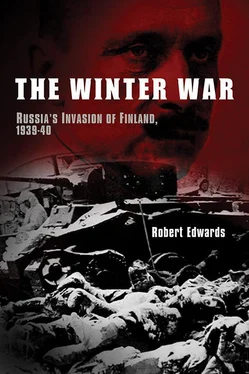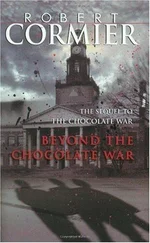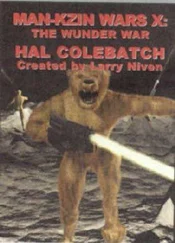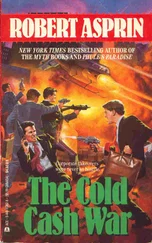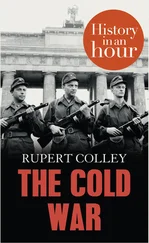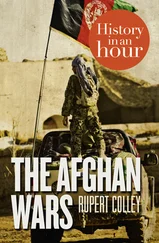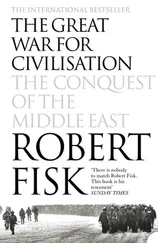The Red Army was not issued with camouflaged uniforms until the end of January.
It has been said, this writer suspects unfairly, that the major motivation for the dogged persistence of the Red Army soldiers lay in the bloodcurdling threats offered in their indoctrination. Yet it is a Russian tradition…
It had been considered sensible by the Finns to use Soviet-calibre ammunition (7.92 mm in 1939) in the bulk of their infantry weapons; either that or international standard ‘Parabellum’ (9 mm. or short .38in.) rounds. In general, this is still Finnish policy.
The bulk of this material was dehydrated millet gruel and pork fat; little vodka was recovered, but many useful empty bottles. For the Muslim soldiers of the Red Army (of which there were naturally very many) this haram (forbidden) provender was hardly an appetizing prospect.
It is quite possible that Russian reinforcements were actually ‘blocking’ units, there to prevent retreat rather an assist in attack.
A Red Army colonel, Raeskii, had already suggested this policy of ‘thorough combing’ (sploshnyi piochesyvanie) on the Isthmus. It was rejected; not enough Red Army soldiers knew how to ski.
Akhmedov, op. cit., p. 114.
It had not been the habit of the Red Army to stage exercises either at night or in temperatures below -15°. In Finland, the short winter days, with less than six hours of daylight, coincided with the lowest temperatures recorded since 1828.
The Moisin rifle was the basic long-arm of the Finnish Army, too. The important difference was really the lubricants used. The Finns used a combination of alcohol and glycerine.
Most famously the T-34.
The 44th, despite being a motorized division, had with it over 1,200 horses, for the use of both cavalry and transport.
Akhmedov, op. cit., p. 113.
This is not to assume that the Finns were immune to frostbite and its attendant perils; far from it.
Throughout the whole war, the Finns were to take less than 6,000 prisoners, out of a total of 1.2 million Russians involved in battle. Many Red Army soldiers clearly preferred suicide rather than surrender—it had been made clear to them by politruki that their families would be at risk in the event that they capitulated. No accurate numbers exist for this; the ‘extraordinary occurrences’ files covered mutiny, self-injury, drunkenness, cowardice, desertion and insubordination, but not—perhaps sensibly—suicide.
Akhmedov, op. cit., p. 120.
And presumably shot; there is certainly no record of him from February 1940 onwards.
Beria had replaced N. N. Ezhov as head of the NKVD in December 1938. Whereas Ezhov had been an alcoholic bisexual, Beria was merely a heterosexual paedophile. For reasons unassociated with this narrative, Ezhov was executed on 4 February 1940.
Akhmedov, op. cit., p. 120.
The suspension of dual command by Timoshenko (see Chapter 11) had an immediate effect upon the willingness of commanders to state their concerns.
van Dyke, Soviet Invasion of Finland, p. 88.
There has in no case been discovered any surviving prisoner of war who returned to Russia, leading to the supposition that none in fact survived after repatriation in 1940. This is supported by later comments.
News Chronicle, January 1940.
See page 125.
Finnish Meteorology Yearbook, 1940, vols. I & II.
There is no recorded wind chill factor applying here; temperatures are measured statically.
By the 80th Air Regiment of the Ninth Army.
Until the summer of 1941.
Langdon-Davies, Finland—The First Total War , p. 61.
Or, at least, it looked like a coup d’état; there had been an attempt to kidnap President Svinhufvud, which had failed, utterly.
Essentially, these were agricultural machines and, importantly, not armoured. Simply, a moving traffic jam.
Mannerheim, Memoirs , p. 334.
Chew, The White Death, p. 36, citing Honour and Fatherland: The Russo-Finnish War, 1939-40, by Tuompo and Karikoski.
In 1935, Mannerheim himself had said derisively (and presciently): ‘If a company of Russian soldiers could be dropped suddenly into the middle of one of our prosperous country towns, they would probably be too surprised to fight. They would set about eating instead.’ See Forbes, The Men I Knew, p. 275.
But not for long; Shtern was executed by firing-squad in June 1941 for reasons unassociated with this narrative. He was later ‘rehabilitated’.
Mannerheim, op. cit., p. 337.
The 139th Division lost well over 4,000 dead just on the Ägläjärvi road, without factoring in the fighting on and around the lakes, let alone reconnaissance groups, many of which simply disappeared, never to be found, like the lost legions of Varus.
Khadzhen-Umar Dzionovich Mamsurov (1903-1968), then a regimental commander, Ninth Army.
Chubaryan & Shukman, Stalin and the Soviet-Finnish War. p. 236.
After the war, Stalin would invent a new, chilling term: artillery ‘processing’, reflecting the industrial imagery of war, which he clearly found so satisfying.
In this sense, the frequencies of the various radios were not harmonized.
Chubaryan & Shukman, Stalin and the Soviet-Finnish War, p. 259.
It was quickly realized that the Finnish anti-tank obstacles were insufficient for the task, being simply not large enough.
The full text of Yanov’s account can be found at the National Archives in Kew, War Office 208/582. Carl van Dyke (Soviet Invasion of Finland p. 100, n. 145) points out that Yanov’s abandonment of his tanks could constitute the breaking of his ‘soldier’s oath’, a serious matter under fire. Mannerheim recalled: ‘A Russian tank commander who deserted to us [perhaps Yanov] gave as his motive his fear of facing his superiors after his losses.’ Memoirs, p. 343.
Mannerheim, op. cit., p. 344.
Several of these letters bear no evidence of a military censor, which is perhaps surprising.
Mannerheim, op. cit., p. 344.
Mannerheim, op. cit. , pp. 344-5.
All three journals 23 December 1939.
Читать дальше
